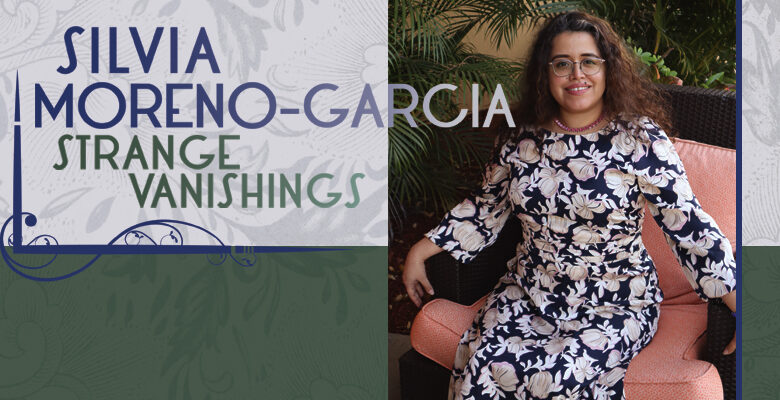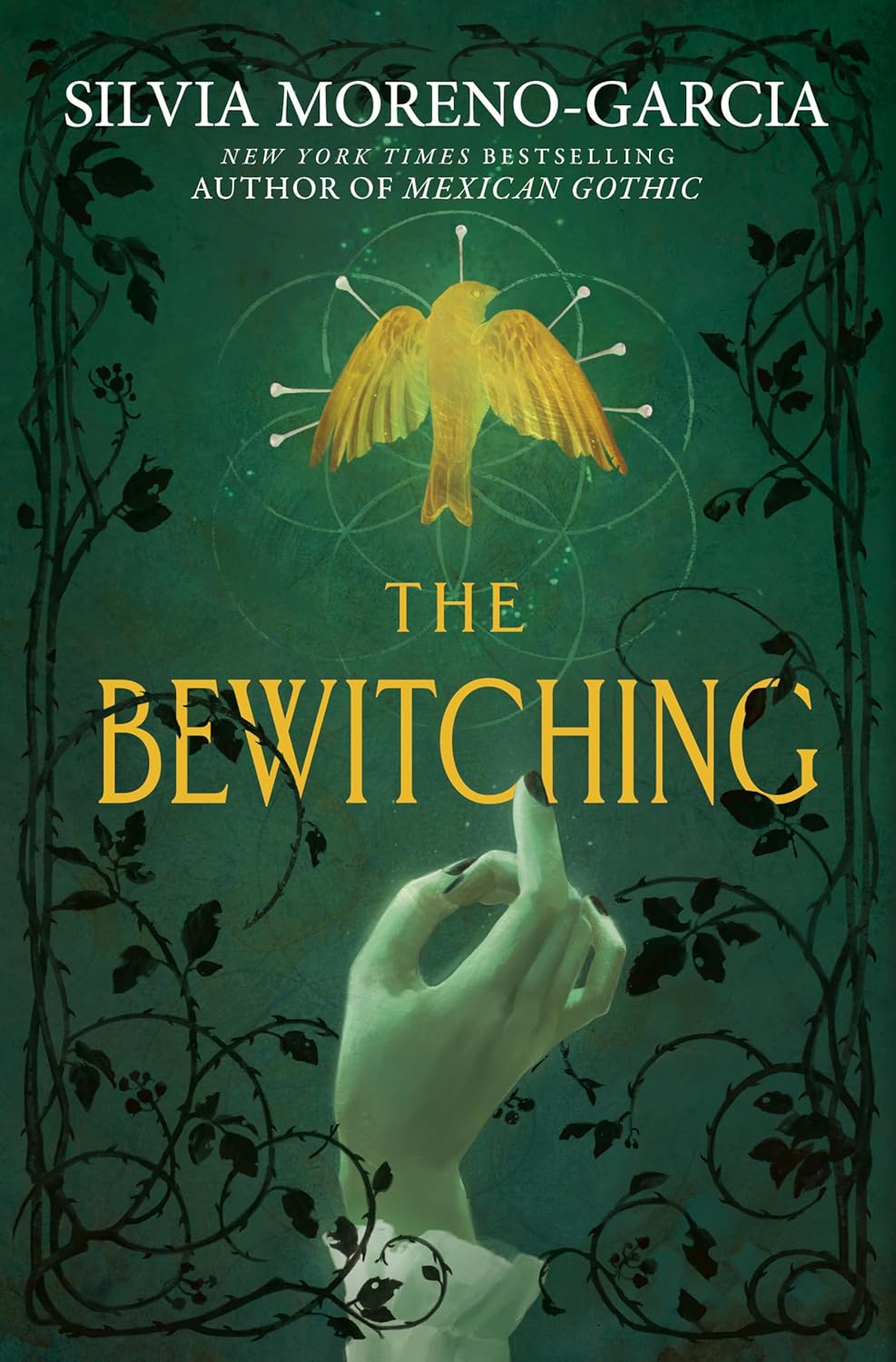Strange Vanishings – Locus Online

 SILVIA MORENO-GARCIA was born April 25, 1981 in Baja California, Mexico, and grew up in various places throughout the country. She attended Endicott College in Massachusetts, where she studied communications, then returned to Mexico, where she married her husband; they immigrated to Canada and have two children. She studied journalism in Canada and earned a Master’s in Science and Technology Studies from the University of British Columbia.
SILVIA MORENO-GARCIA was born April 25, 1981 in Baja California, Mexico, and grew up in various places throughout the country. She attended Endicott College in Massachusetts, where she studied communications, then returned to Mexico, where she married her husband; they immigrated to Canada and have two children. She studied journalism in Canada and earned a Master’s in Science and Technology Studies from the University of British Columbia.
Moreno-Garcia and Paula R. Stiles launched weird fiction publisher Innsmouth Free Press in 2009. They published 15 issues of Innsmouth Magazine from 2009-14, along with numerous anthologies, including several co-edited by Moreno-Garcia & Stiles: Historical Lovecraft: Tales of Horror Through Time (2011), Candle in the Attic Window (2011), Future Lovecraft (2011), World Fantasy Award winner She Walks in Shadows (2015; as Cthulhu’s Daughters: Stories of Lovecraftian Horror, 2016), and Sword & Mythos (2014). She also co-edited Fungi (2012) with Orrin Grey. Her anthologies from other publishers include Dead North: Canadian Zombie Fiction (2013), Fractured: Tales of the Canadian Post-Apocalypse (2014), and Nebula Awards Showcase 2019 (2019). She became co-editor of The Dark in 2016.
Moreno began publishing short fiction in 2006, and her work has appeared in Shimmer, Nightmare, Fantasy, and other magazines, plus various anthologies. Some of her stories have been collected in This Strange Way of Dying (2013) and Dreamlands (2021), and novella Prime Meridian appeared in 2017.
Her debut novel Signal to Noise (2015) was a finalist for Aurora, Sunburst, and British Fantasy Awards, and won a Copper Cylinder Award. Gods of Jade and Shadow (2019) won an Ignyte Award and a Sunburst Award and was a finalist for the Nebula Award, and Mexican Gothic (2020) won British Fantasy, Locus, and Aurora Awards and was a finalist for World Fantasy, Bram Stoker, and Nebula Awards. Other novels include Certain Dark Things (2016), The Beautiful Ones (2017), Hugo Award finalist The Daughter of Doctor Moreau (2022), and Silver Nitrate (2023). She also writes crime fiction.
Her latest novel is multigenerational horror The Bewitching (2025).
Excerpt from the interview:
“When I was a small child, we lived in the border zone, in Baja California; going through the border was a very fluid thing. If you wanted to shop for certain things, you would shop for them in the US, stuff that you couldn’t get in Mexico at the time. You could find it in Mexico City if you knew the right places, the right shops – they would have certain kinds of comic books or books that came in, somehow. But none of that would be translated, and you didn’t want to wait for a book to be translated, right? You wanted to read the latest Stephen King and not wait six or eight months. My mom and I would drive over on a weekend, fill a box with books and take them back. We all kind of speak English in the border zone as a natural, necessary survival skill, because you’re so close to the American side, and lots of people come over to the Mexican side for business. But my mother developed her English beyond just pleasantries – she really learned how to read very well in English because she was a big Stephen King fan, and she just wanted to read the latest Stephen King before it got to Mexico. My father, who’s passed away now, was more into sci-fi. He was the Dune guy, and he also learned to read in English, eventually, because he wanted to read more of those writers.
“I grew up reading English and Spanish for that reason, because they had a lot of speculative books in my house, both in English and in Spanish. I remember having weird sensations rereading a book in English after having read it first in Spanish and being like, ‘Wait…’ It’s a weird kind of déjà vu because I read it, but not in that language. Peter S. Beagle’s The Last Unicorn is one that I first read in Spanish and then read in English, and some of the wordplay he does in English was obviously not translated well into Spanish, and some of the songs were not the same. So, sadly, the butterfly song is not the same at all. That happened with several books.
“Sometimes the artwork was very different, in terms of what would be printed in an edition for the Mexican market versus for the American market. I guess it’s the same with any edition, but sometimes it would be drastically different – you would get a cover that didn’t seem to fit the title at all. Different markets have different needs.
“My mother was – and is still, now, but less so – a huge horror buff, so she tended to have a lot of horror paperbacks. It was the ’80s, the heyday of the horror boom, so I read an Edgar Allan Poe collection we had in the house. I told her, ‘I want to read more stuff like this.’ She gave me a Lovecraft story. H.P. Lovecraft really was useful as an introduction to all the pulp writers – he was a gateway to Clark Ashton Smith, Robert E. Howard, C.L. Moore, all that Weird Tales crowd. From that, I started moving through the decades, and finding more.
“I grew up on two tracks, because my parents like sci-fi and fantasy and horror, and that was basically the bulk of it, British or American, maybe some French here and there like Verne. Anything that we could call fantastic as opposed to ‘genre’ was probably published under a literary label, considered ‘serious fiction.’ Pedro Páramo does have ghosts and supernatural elements, things that do not belong in the realm of the realistic, and yet, it was published very much as ‘serious’ literature that literary salons would read about. That happened with the bulk of fantastic fiction.
“Comic books were a completely different story, and comic books opened an entirely different pathway into the pulps. Pulp fiction did not make it into Mexico in the same way – it was not like the US, where you had Analog and you had Weird Tales and eventually that led to the birth of the paperback, and the paperback eventually made way for the hardcover. There was not enough of a literary or mass consumer audience for those. Comic books reflect the genres more widely. So that’s where you really get ‘genre’: horror, some superhero stuff, some sci-fi, Westerns, crime stories, and romances; they’re all printed in comic-book form.
“Now a lot of them are imitations of American stuff. So somebody sees that the Americans are doing Martian stories, so then we’re going to do Martians here. Americans are doing noir, so we’re going to do noir here. You do find things that are more inspired by local stuff that emerged. The ‘Mexican Western’ with the charro is a very specific kind of Western that incorporates elements not found in American Westerns because we have our own version, based in our own agrarian struggle.
“There are a lot of comics that are influential from when I was a child, because I found those covers to be so interesting – it was more the covers than anything. Sometimes I would read the interiors and the writing was not that great, but the covers were great, they were so inspiring. Somebody’s getting abducted into a saucer and she’s half-naked… there were often half-naked ladies on the cover of these comic books – that was the market that they were serving. She’s getting taken into a saucer and maybe there’s someone with a ray gun…. When I was a child and I was standing at the newsstand and they had all these things: pornographic comic books, Westerns, crime stuff. Then there was the horror, with exciting titles like ‘Possessed by the Devil: She was taken by Satan to a land of terror!’ With a cover of a lady screaming. Or ‘The Ghosts of the Whatever: A Tale of Awful Possession.’ As a child, standing there in front of the newsstand, it just sparked my imagination.
“I’ve collected some really old comic books from that time period, and the unfortunate thing is, because it was considered low art – and still is considered low art, kind of – a lot of this stuff is being lost. The originals were not printed on very good paper, so they’re just falling to pieces, and then people don’t collect them, and people haven’t really catalogued them. There’s a museum of the comic book in Mexico City, but it’s very small and underfunded – that’s where I’ve gotten some of my comic books, just by going there and talking to dealers. They get together on the weekend, so you can go and buy some old comic books.
“There was a golden age of comic books – which doesn’t exist anymore in Mexico, by the way, either. There was this golden age in which you could see a lot of speculative fiction in visual form, and so some of my inspiration comes from that, just staring at those pictures and being like, ‘Oh my god, this is the most exciting thing I have ever seen.’ I bought some, though I didn’t have that much money as a kid, so I couldn’t get them all, but just the act of standing there and looking at them was a whole experience. The stories inside were not sexy, but that was because obviously they were tricking you at the newsstand so you would spend your hard-earned pesos to get the story. It was a feast for the imagination. That is the stuff that resides in my brain and lives there unasked for.
“There were also a lot of low-budget Mexican horror movies that were produced at a certain point. Again, they were not very good, and they were trying to copy some of the American ones, so some are not very original, structurally. But there are also a lot of high-budget movies that are terrible nowadays, so, you know, I take what I can from them. I think Stephen King is the one who said, ‘Some things have gold dust in them, and others have whole nuggets, and others might be a whole gold bar.’ There are some directors who are trying to do something more, some strokes of brilliance, and then some things where you’re like, ‘That cinematography is actually really interesting.’ Not everything is a whole gold bar, but some have traces of gold dust in them.
“I don’t really like the wrestler movies much. Most of the people who know about Mexican horror say, ‘Oh, the wrestler films!’ I find those really boring. There are some other ones that I think are interesting, and they’re not just trying to repeat the same things. They’re more ambitious in some ways – maybe the cinematographer really cared about the backgrounds and the writing and all that, so those are kind of fun. We do have that little visual medium that does exist in Mexico. It’s probably easier to find something recognizable as horror versus Pedro Páramo, which is very literary, and while it does have ghosts, but it’s not really horror.
“Most of my influences are things that I find interesting, in some way or another. I may know more or I may know less about the subject matter, depending on what it is. I know a lot about film history because it’s something I’ve read about since I was a child. I know a lot about classic film stars, what the studio system was like, and that gets reflected in books like Silver Nitrate and The Seventh Veil of Salome, which is not speculative, but is historical, set in Hollywood. Those are things I have a lifelong interest in.
Interview design by Francesca Myman.
Read the full interview in the August 2025 issue of Locus.
 While you are here, please take a moment to support Locus with a one-time or recurring donation. We rely on reader donations to keep the magazine and site going, and would like to keep the site paywall free, but WE NEED YOUR FINANCIAL SUPPORT to continue quality coverage of the science fiction and fantasy field.
While you are here, please take a moment to support Locus with a one-time or recurring donation. We rely on reader donations to keep the magazine and site going, and would like to keep the site paywall free, but WE NEED YOUR FINANCIAL SUPPORT to continue quality coverage of the science fiction and fantasy field.
©Locus Magazine. Copyrighted material may not be republished without permission of LSFF.
Source link




